
Welcome to CivilGEO Knowledge Base
Welcome to CivilGEO Knowledge Base

Welcome to CivilGEO Knowledge Base
Welcome to CivilGEO Knowledge Base
The Renumber Interconnected Diversions command allows the user to automatically renumber diversion structures and connected routing reaches along a defined flow path.
Follow the steps below to use the Renumber Interconnected Diversions command:
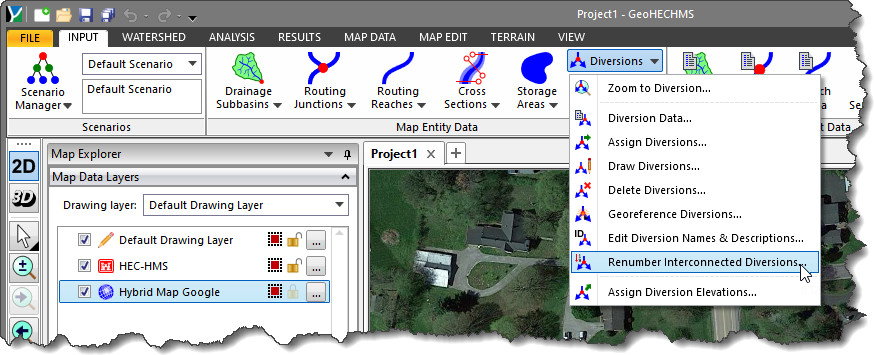
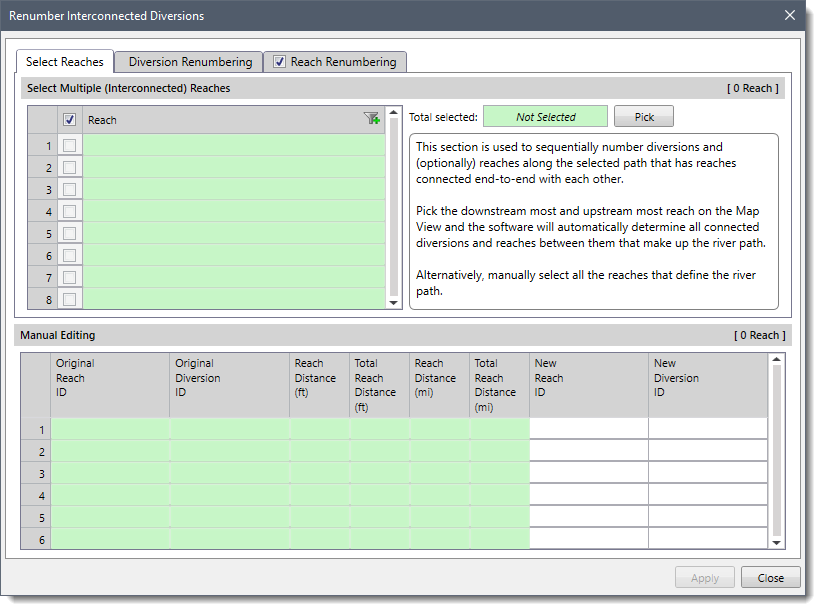
The following sections describe the Renumber Interconnected Diversions command and how to interact with the above dialog box.
The Select Reaches panel is used to select all the reaches that define a flow path.
The Select Multiple (Interconnected) Reaches section is used to sequentially number reaches and diversions along the selected flow path that has reaches connected end-to-end with each other.
The user can click the [Pick] button and select the downstream most and upstream most reach on the Map View, and the software will automatically determine all connected diversions and reaches between them that make up the river path.
If a reach is already selected on the Map View prior to running this command, the same reach will be shown selected within the table.
Alternatively, the user can click the [Pick] button to manually select the reaches from the Map View. On clicking the [Pick] button, the Renumber Interconnected Diversions dialog box will temporarily disappear, and a prompt will be displayed on the status bar instructing the user to select the reaches from the Map View. After selecting the reaches, the user can press the [Enter] key or right-click and choose Done from the displayed context menu. The Renumber Interconnected Diversions dialog box will be redisplayed, and the total number of selected reaches will be displayed in the Total selected read-only field.
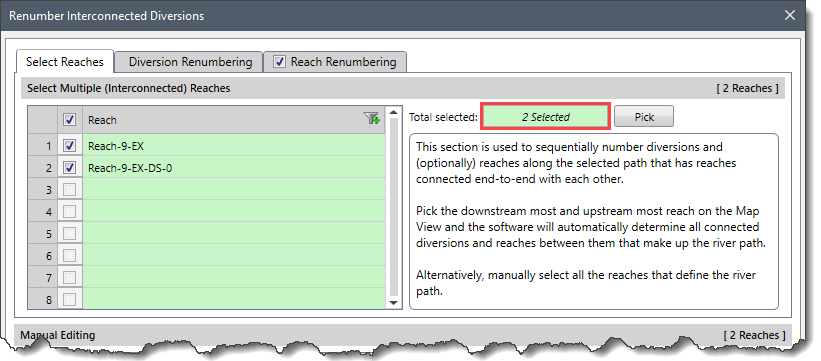
Note that the user can select multiple reaches from the Map View prior to running the Renumber Interconnected Diversions command by holding the [Ctrl] key while selecting the desired reaches.
This section contains a data grid that lists the IDs of the selected reaches and diversions. The data grid also lists the reach distance and total reach distance in miles and feet. The values in the last two columns of the data grid provide a preview of the reaches and diversions naming specifications defined in the Diversion Renumbering and Reach Renumbering panels.
This panel allows the user to number diversions based upon diversion stationing or incrementally.
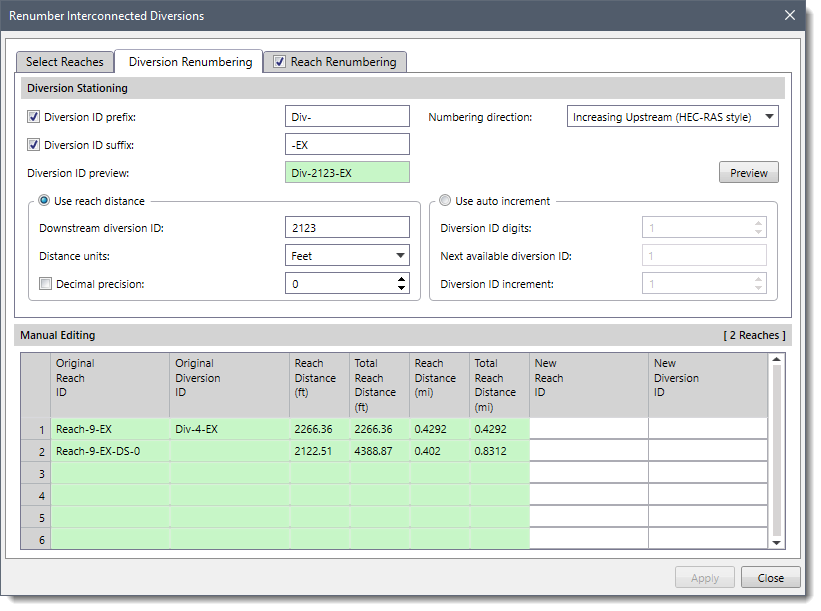
This section is used to define diversion stationing. Diversions can be numbered using a fixed increment or by the river chainage along the river reach. The river chainage can be in miles or feet if working in US units, or kilometers or meters if working in metric (SI) units.
The following options are provided in this data panel:
This subsection is used to number the diversion by using the river chainage along the river reach. The following entries are provided:
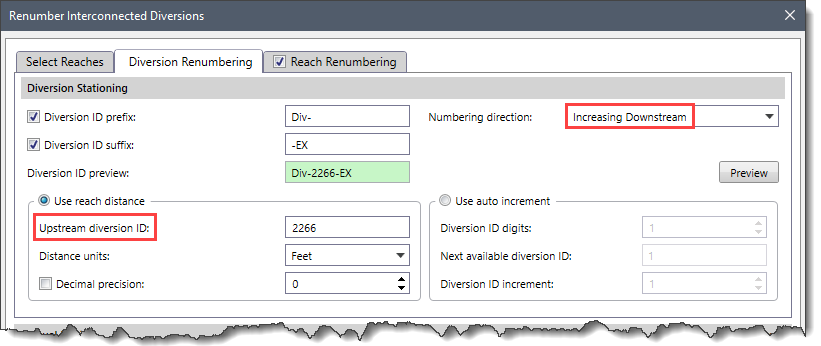
This subsection is used to number the diversion using a fixed increment. The following options are provided:
Clicking on the [Preview] button causes the software to fill the diversion IDs in the New Diversion ID column of the Manual Editing data grid.
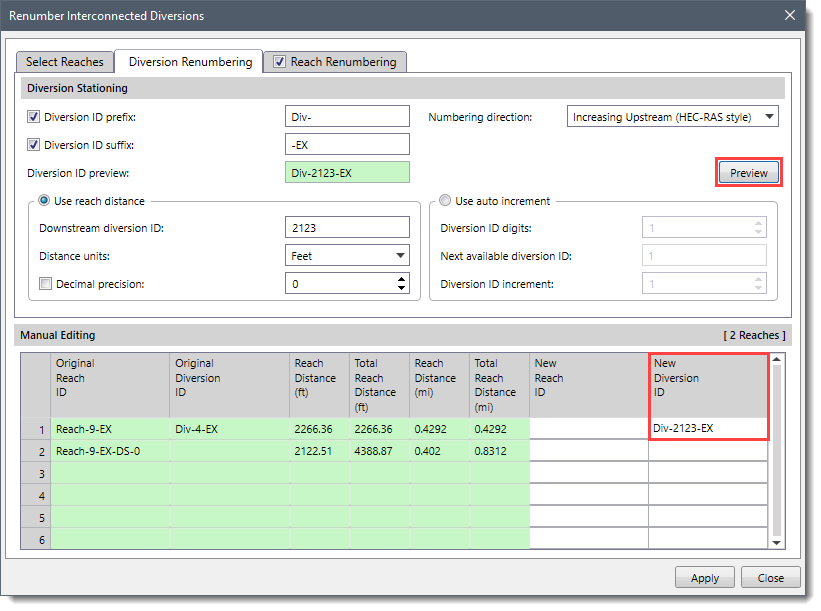
This panel allows the user to number the reaches based upon river chainage or incrementally. By default, the Reach Renumbering checkbox panel is checked. If the panel checkbox is unchecked, then the content of this panel will be disabled and the reach will not be renumbered.

This section is used to define the river stationing to be used for the constructed reaches.
The following options are provided in the data panel:
This subsection is used to number the reach by using the river chainage along the river reach. The following entries are provided:
The Use auto increment subsection is used to number the reach using a fixed increment. The following options are provided:
Clicking on the [Preview] button causes the software to fill the reach IDs in the New Reach ID column of the Manual Editing data grid.
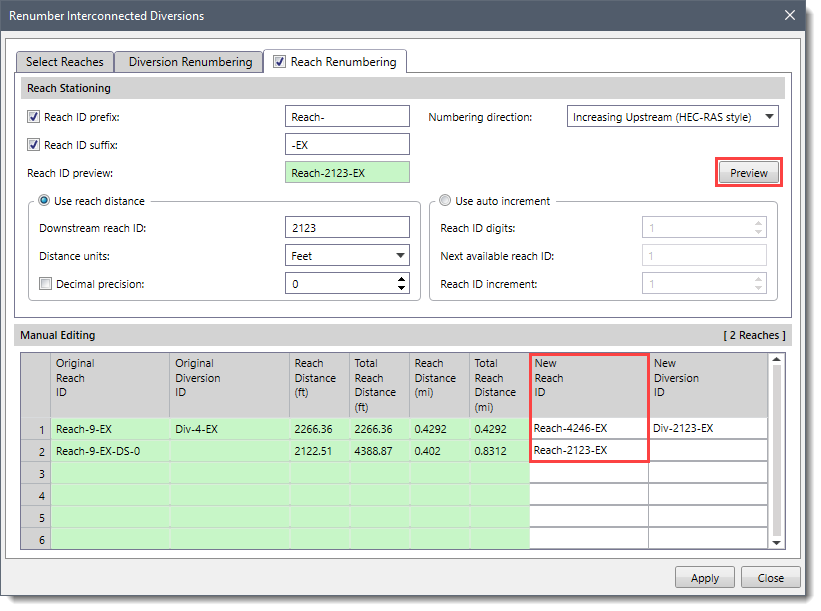
When the data have been defined in the Renumber Interconnected Diversions dialog box, click the [Apply] button. The software will then renumber the IDs of the diversions and reaches along a defined flow path.
 1-800-301-02-955
1-800-301-02-955
 608-729-5100
608-729-5100
(US and Canada)
 [email protected]
[email protected]
 +1 608-729-5100
+1 608-729-5100
CivilGEO India
Graphix Tower, A-13 A
3rd Floor, Sector 62
Noida, Uttar Pradesh 201309
IndiaTel:
1-800-301-02-955 or
+91 022-3831-8601
CivilGEO United States
8383 Greenway Blvd
6th Floor
Middleton, WI 53562
USATel:
608-729-5100 or
800-488-4110
Copyright © CivilGEO, Inc. All rights reserved. The CivilGEO logo, “GeoSTORM”, “GeoHECHMS”, “GeoHECRAS”, and “Ready To Engineer” are registered trademarks of CivilGEO,Inc.
All other brands, company names, product names or trademarks belong to their respective holders.
We use cookies to give you the best online experience. By agreeing you accept the use of cookies in accordance with our cookie policy.
When you visit any web site, it may store or retrieve information on your browser, mostly in the form of cookies. Control your personal Cookie Services here.
The ZoomInfo WebSights snippet drops three cookies to track Unique Visits:
1. _pxhd - Related to the Perimeter X security layer (Perimeter X isused to prevent bot attacks).
2. _cfduid - Related to the CloudFlare security layer (CloudFlare is the Network Security protocol that ZoomInfo uses to orchestrate the rate limiting rules).
3. visitorId - This is how WebSights identifies recurring visitors








